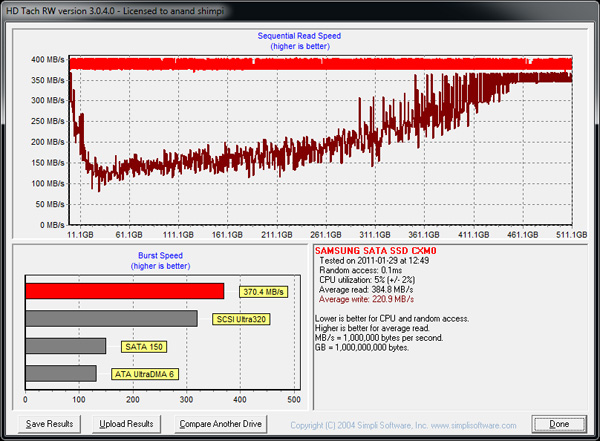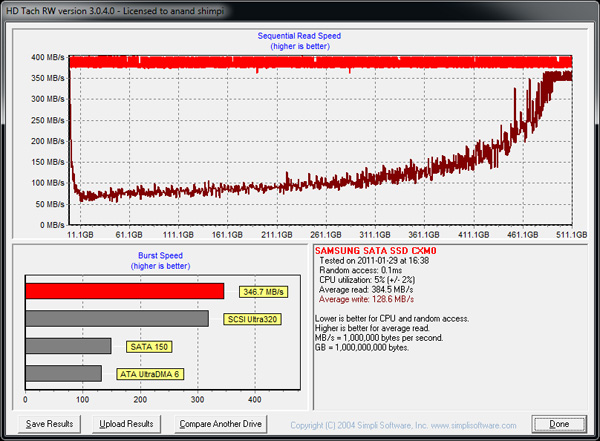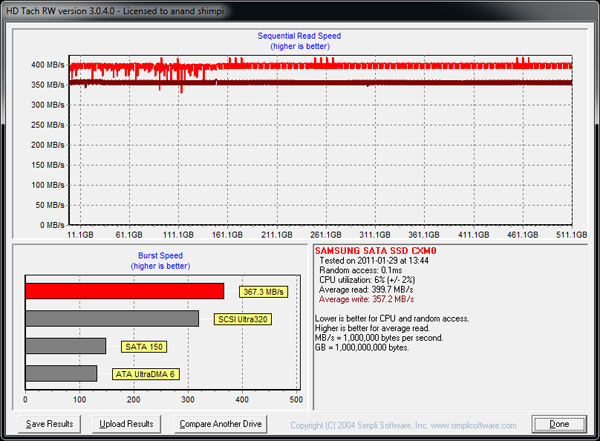The Samsung SSD 830 Review
by Anand Lal Shimpi on September 24, 2011 1:02 AM EST- Posted in
- SSDs
- Storage
- Samsung
- pm830
- Samsung SSD 830
Performance Over Time & TRIM
My biggest issue with Samsung SSDs in the past has been their extremely poor performance over time. Samsung doesn't do a lot of active garbage collection while writing in order to maintain ultra high write speeds, instead it prefers to clean up the drive during periods of little to no IO activity. Unfortunately this approach can result in pretty poor performance over time. In the old days the Samsung controllers would hit single digit write speeds, often slowing down to sub-HDD speeds. These days things are a lot better but it's still a concern. To quantify the behavior I filled all user addressible LBAs on the SSD 830, then proceeded to run our random write torture test on the now-dirty drive. After 20 minutes of torture I ran a single sequential read/write pass to measure how much of a hit the drive took.
Sequential read/write performance should be around 400/330 according to Iometer. Here's what the drive looks like after our torture test:
There's a significant drop in performance but the drive is still able to deliver ~100MB/s speeds. This graph is a bit deceptive however. After 20 minutes of 4KB random writes the SSD 830 will only write at a rate of around 20MB/s. By not doing much realtime garbage collection the random write speed can drop significantly over time, but at a lower write speed the 830 isn't penalized as much as other drives. To help deal with this issue I extended the length of our torture test to 60 minutes and re-ran:
Ah that's a lot more like it. Performance drops significantly, down to as low as 50MB/s for the earliest LBAs. Given enough idle time the 830 should correct much of this and obviously TRIMing those LBAs will restore full performance (as you'll see below) but the point is that by delaying the bulk of garbage collection the Samsung SSD 830 is able to drop in performance by a degree that I'm not super comfortable with. This phenomenon isn't exclusive to Samsung, you'll remember that we've complained about it with Crucial drives as well. Other than SandForce and Intel most controller manufacturers tend to follow a similar clean up the mess later approach to firmware design. In my opinion I'd much rather see lower peak performance and get higher worst case scenario performance as it tends to impact the user experience less.
If you are running under a TRIM enabled OS performance does restore to peak quite nicely after a TRIM pass:













99 Comments
View All Comments
Out of Box Experience - Saturday, September 24, 2011 - link
Compatability?As far as I am aware, Intel and Samsung were the only drives compatible with XP and every other OS out of the box
Am I wrong on this point?
I believe ALL other SSD's require Partition Alignment for compatability
It would be nice to get an update to see if ANY newer 6Gbps are compatible with every OS out of the box like the Samsung 470 and Intel drives
Is there a compatability list floating around somewhere Anand?
A Google Search turns up no reliability issues from anyone who actually knows what they are doing either
If you want to find hundreds of reliability or compatability issues, just visit the OCZ Forum or go read the Newegg reviews
or go sleep it off
extide - Tuesday, October 4, 2011 - link
EVERY SSD should be 4KB aligned for best performance.Out of Box Experience - Wednesday, October 5, 2011 - link
Intel and Samsung SSD's do not require end user alignmentOnly SSD's that do not have the offset in firmware require alignment
kake - Saturday, September 24, 2011 - link
I like your mic.sequoia464 - Saturday, September 24, 2011 - link
Quite a bit more juice running through them than the other drives - is this partly from the 256 mb cache?tipoo - Saturday, September 24, 2011 - link
Even the most power hungry SSD's don't require any additional cooling. It may look big on the graph, but that's still sucking way less power than most things in your system like the processor, graphics chip, etc. It just won't produce that much heat.sequoia464 - Saturday, September 24, 2011 - link
Thanks, Reason I asked is that My Toshiba based Kingstons seem to run (at least to the touch ) cooler than my both Intels and Vertex2's. (not that they are hot by any means, just warmer).Probably the workload and usage that is at play here - now that I think about it.
name99 - Saturday, September 24, 2011 - link
Different people have different concerns.Yes, if you install this in a desktop box power is not an issue.
If you install it in a laptop, the concern is probably not the thermal load but the maximum power draw. If your laptop is not specced to handle that, you'll find the machine crashing when you do a lot of back-to-back writes.
Same thing if you hoped to use it in a USB enclosure, whether USB2 or 3.
Jaybus - Tuesday, September 27, 2011 - link
Probably a combination of things. Certainly, the DRAM is much larger than what is used by the other drives. Also, notice that this 512 GB version is being compared to 256 GB drives, so right off the bat its flash is taking twice the power as those it is being compared with. This was mentioned in the article. Samsung has not yet supplied a 256 GB version for testing. So I doubt it is a controller issue. Probably just the fact that it has twice the flash.infini - Saturday, September 24, 2011 - link
I don't think Intel is the king of reliability with the 8mb problem of the 320 series. Beenthere can you provide a link with compatibility and reliability problems of Samsug drives?